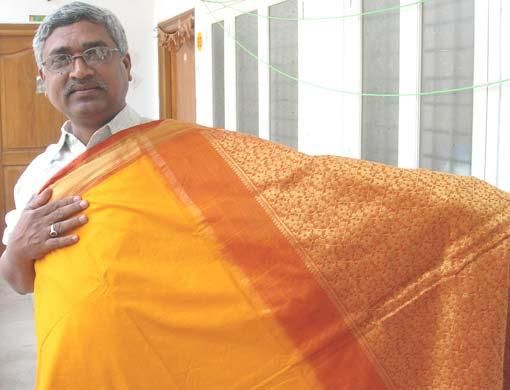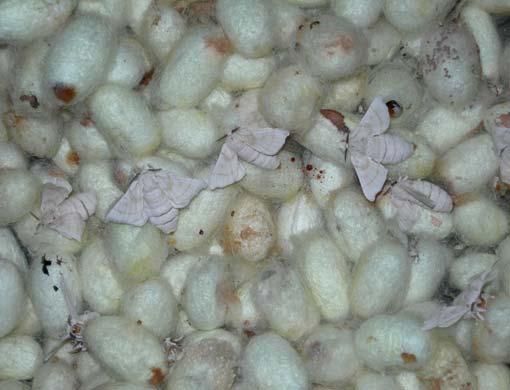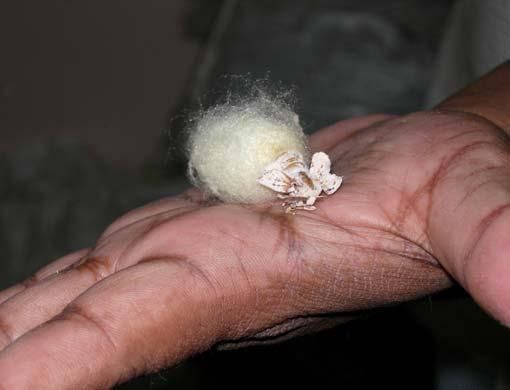People like silk garments. But they come at a cost - 50,000 silkworms for a sari. Mythily Ramachandran meets Kusuma Rajaiah, whose ahimsa silk initiative has revolutionised the industry.
It all started almost 5,000 years ago in a Chinese garden. Legend has it that silk was discovered by a Chinese empress when she plucked a cocoon from a mulberry tree and it accidentally fell into her cup of tea.
She watched amazed as a strong white thread unravelled. This incident saw the birth of silk. Due to its desirable properties and reputation as a luxury fibre, silk became a sought after commodity and soon spread to other parts of the world.
Since its discovery the lives of the silkworms hang on a strand of thread. Literally so, when you look at the statistics: 15 silkworms are killed to produce one gram of woven silk. Around 1,500 pupae are put in boiling water to yield 100 grams of silk. The production of a silk sari costs the lives of 50,000 worms.
For all the shimmer, elegance and rustle of silk that most of us covet, little do we know that as we bask in its shining glory, it comes tainted with the shame of killing numerous, helpless silkworms.
Fortunately these worms have found a sympathiser in Kusuma Rajaiah of Hyderabad, who produces eco-friendly ahimsa silk. It is called ahimsa silk because its production process does not entail killing the worms.
Meeting Rajaiah at his house in Hyderabad you can't miss the large wicker baskets storing thousands of cream cocoons. A close look reveals a few moths that have just emerged from their cocoons.
Warm and friendly, Rajaiah points to the opening at one end of the cocoon pierced open by a moth. A cluster of tiny yellow eggs is spread on another cocoon.
"The adult moths have a short life span, around 3-5 days. During this time they mate and die naturally," says this senior technical officer working at the Andhra Pradesh Handloom Weavers Cooperative Society (APCO).
Silk without violence
It is these pierced cocoons that Rajaiah uses for the manufacture of silk, unlike the conventional method used in the silk industry, where cocoons carrying the worms are destroyed.
In silk manufacturing units, cocoons are purchased from farmers when they are 10 days old and just a week before the moth emerges.
The silk filament is believed to be at its finest at this stage. These cocoons are steamed or put into a bath of boiling water at a temperature of 70-90°C.
The silk is reeled from the cocoon and subsequently processed into yarn.
"They prefer this treatment because when the cocoons open naturally to release the moth, the continuity of the fibre is lost. It cannot be reeled and leads to wastage," explains the 52-year-old crusader for silkworms.
But Rajaiah inspired by Mahatma Gandhi's philosophy was keen to find an alternative to this conventional method that eliminated thousands of worms.
He says , "In the 1990s Janaki Venkataraman, wife of the former President of India, R. Venkataraman, visited Hyderabad and during this trip she came to APCO and wanted to buy a silk sari.
"But the problem is she was not just looking for an ordinary silk sari, she wanted one that did not involve the killing of silkworms. Unfortunately, we didn't have any and she left disappointed," he says.
A couple of years later, actress and animal activist Amala Akkineni came looking for the same silk.
Rajaiah, who has always been keen to take up new challenges, saw this as an opportunity to advance his philosophy of non-violence and cruelty to animals.
The beginning
Thus he began researching and looking into the possibilities of producing silk without having to kill the silkworms. His project kickstarted in 2000.
With a loan from his Provident fund he purchased his first batch of cocoons from a farm in Chittoor district and reared them at home. However, he had overlooked certain factors in the line of production.
"When the moths emerged and the cocoons were ready to be spun into yarn, I discovered that there was no unit in Andhra Pradesh equipped for this kind of work," he recalls.
Not one to give up, Rajaiah's search took him to Chattisgarh where the cocoons were spun into yarn by machines. Well, just as he thought he had everything covered he was in for a surprise.
"I only got 16 kg of yarn from 100 kg of cocoons delivered. I later learnt that when the cocoons are pierced the continuity of the filament is lost, hence the silk cannot be reeled.
"The silk that is drawn out looks more like clumps of cotton. It is twisted, finer and more elastic and can only be machine spun into yarn. A lot of wastage is inevitable. And that explains the higher tag on 'Ahimsa silk', compared to regular silk", says Rajaiah.
It wasn't easy for Rajaiah to juggle his home experiment and work. However, he was rewarded for his hard work when he produced the first four saris.
"This first batch gave me fulfilment and energy to forge ahead. It enabled me to live by my principle. I realised after all it was possible to produce this lovely fabric without killing the worms.
"Well, this eco-friendly silk may not be as shiny as regular silk but it is wrinkle free and has better drapability. Besides being porous it is comfortable to wear," he says.
He called his creation ahimsa silk. Amala Akkineni purchased one of the saris. By 2001 he had produced more saris and put them on the market.
As the business grew he decided to apply for a patent in 2002. He finally received the document in 2006 giving him the right to produce and market the eco-friendly silk for the next 20 years.
His wife Savithri helps by sorting out the cocoons and moths while daughter Avani, 21, chips in with ideas on designing.
Clientele
His customers include well-known personalities such as animal activist Maneka Gandhi and Sheila Dixit, Chief Minister, Delhi, as well as other animal rights activists. And yes, Janaki Venkataraman received one when she visited Hyderabad.
Megawati Sukarnoputri, former Indonesian President, purchased six saris in 2002 at a symposium in Jakarta. Jennifer Yost, who fondly calls him appa and Gina Moore, both from the US, ordered ahimsa silk for their wedding gowns.
"People are becoming aware of this eco-friendly silk thanks to the media and exhibitions I hold alongside APCO. Customers often approach me after visiting my website.
"For instance, recently Pascal and Guitha Samy, designers from Geneva and Nerul Rodriguez, a designer from Paris, came down to India to discuss the possibilities of establishing a business dealing in ahimsa silk products in Europe.
"Since the business is growing I have increased production to 1,000m of ahimsa silk per month on average. However, if there are more orders I can go as high as 5,000m," he says.
Rajaiah has a range of 30 designs and his saris include Kanchipuram, Kalakshetra, Ikkat, Jamdani and Kalamkari. Customised orders are also taken. Besides saris he also makes dupattas, stoles, dhotis and fabrics from ahimsa silk.
"From the wastage we produce ahimsa noil that is used for making shirts and kurtas," says Rajaiah. While he owns a shirt and pair of trousers made of ahimsa silk other family members don't.
"Ahimsa silk is expensive, however when my business improves I will design a sari for my wife. Maybe this Dussehra (a festival in October) I will surprise her," says Rajaiah.
Someday Rajaiah dreams of setting up a unit where everything will be done under one roof, from rearing the cocoons to spinning, processing and marketing the products.
You can contact Kusuma Rajaiah at: designer_weaves@rediffmail.com or rajaiahk@gmail.com or visit his website:www.ahimsasilks.com















